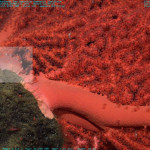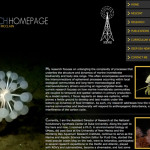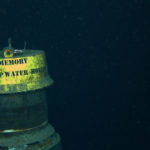
The bamboo coral Isidella tentaculum finally rolled of the presses over the holidays. I can finally speak the name aloud. DSN debuted the video of the actual moment of discovery at Discovery Channel in concert with the 4th International Symposium on Deep-Sea Corals. I went through several names before I settled on I. tentaculum. But, one sure way to know you’re looking at I. tentaculum is the trailing tentacles you see in the video, and at the base of the colony in the image to the left.
The image to the left is the living holotype colony, at 750 m on Dickins Seamount in the northeast Pacific. The holotype is the one colony to which all others will be compared. I chose this one because it was the best preserved and best documented. Notice this colony (~1 m across) is providing habitat for at least 5 galatheid crabs. That’s an important ecosystem function .
A paratype is another type specimen, like the one on display at the Smithsonian’s Sant Ocean Hall. The tissue is preserved and archived at Smithsonian National Museum of Natural History so that researchers from far and wide can access the material to their studies. This is one of the important services that museums provide, but we don’t think much about.
One of the interesting benefits of a career in taxonomy is that you get to name new species. Naming a new species is tricky, but there’s a joy in the process that must harken back to Adam. People are inclined to believe a scientist’s first choice is to name a species after himself or herself. But it doesn’t really work that way.
In taxonomy, there are three ways to go about naming things. The first, and most desirable, is to name the species after a characteristic. Grandis for big, elongata for long, rubra for red, the color of ruby. But this can get boring. There are way too many grandis in the world already. The second approach is to name the animal after a geographic region, hence pacifica, or boat or an expedition, hence Alvinocaris and Sibogagorgia. The third approach is partimonial, to name the species after a colleague, a donor, a girlfriend, or even an enemy (if its particuarly small or ugly). This is how you end up with species like Philautus mittermeieri a species of frog in the Rhacophoridae family, named after Conservation International’s co-founder Russ Mittermeier. Russ falls in with the colleagues or donors (just to be clear).
Many fun stories in this last category, as you might imagine. There’s the reptile genus Montypythonus, for example. And the clam taxonomist who waited for years to name a new species of the genus Abra, … cadabra. According to my advisor, “you can pick almost any famous rocker, musical group, or movie star, and there will be a species named after them”. Oh, the joys of taxonomy. Introducing humor in scientific names is frowned upon by the International Commission on Zoological Nomenclature, but the first person to introduce humor (and insults and barbs) to scientific nomenclature was actually the founder of the system, Carolus Linnaeus.






It’s nice to know that taxonomy is still alive and well.
Definitely here at DSN. Kevin and I both practice the taxonomic arts. Craig’s a mollusk man. We’re all interested in evolution, ecology, and biogeography, where species are the currency of trade.
Taxonomy is very well and alive! I have 5 species descriptions coming out in the next couple months. More about that when they are published.
It unfortunate though that many consider taxonomy a lost art. We are generating unprecedented amounts of biodiversity data. Taxonomy is severely understaffed and underfunded. The backlog of specimens is so great I’ve had researchers turn down samples because they just don’t have the time and money to get to any more new stuff.
Fix??
I don’t see much push at my undergrad program to generate interest…
At UC-Davis, there was an interest in systematics. Courses in Invertebrate Zoology, Ichthyology, Mammology, Entomology, Nematology, Ornithology and Herpetology. I took a senior level class in Systematics. Of course the plant people had their classes as well.
At Penn State, nothing. There was a seminar/discussion course in systematics, but it was always one lab and 2-3 students. They always read fish papers and it felt more like their lab meeting, so i stopped going. Entomology has a course but they sometimes can’t find a faculty member or grad student to teach it.
The interest has to start with the department and faculty. If they are into the students will be. I had a butterfly taxonomist/ecologist teach my Systematics course at UC-Davis. We made phylogenetic tress from “morphological” comparisons of hardware using the different philosophies of tree-building. It was brilliant and we had so much fun!
TAMU-CC is not a big school, but there’s at least one three credit class in Systematics, focusing on the fishes. I agree with Kevin it depends on the faculty. Here, the faculty are supportive, hiring post-docs interested in taxonomy, purchasing equipment like SEMs, and developing molecular techniques to discern species. However, species descriptions will not be part of one’s dissertation. That’s verboten. All species descriptions are independent of thesis work because a species published in a dissertation, but not then in the literature, could result in nomen nudem.
Identifying the Bird, When Not Much Bird Is Left
http://www.nytimes.com/2009/01/25/science/25birds.html?ref=us
Interesting NY Times story on one real-world application of taxonomy.
I would have named it as “Sea Noodles Queen” Lol